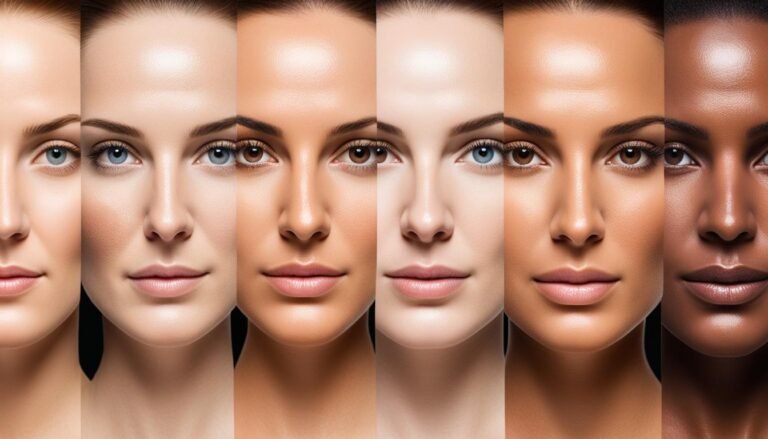Which country has the fairest skin?
When it comes to fair skin, one country stands out among the rest. Their pale complexion is renowned around the world, but what sets them apart? Is it their genetic code or something else entirely?
The Irish people are known for having the fairest skin in the world. But why? What is it about their genetic makeup that makes them the palest people on the planet?
Join us as we delve into the fascinating world of fair skin and uncover the secrets behind its origin and characteristics. From understanding the genetic mutations responsible for fair skin to exploring the geographical factors that contribute to its prevalence, we’ll unravel the mysteries that lie behind this unique trait.
But fair skin isn’t without its challenges. Higher sunburnability and an increased risk of skin cancer necessitate a vigilant approach to sun safety. Discover the best ways to protect your fair skin and keep it healthy and radiant.
Key Takeaways:
- The Irish people possess the fairest skin in the world.
- A specific gene mutation, SLC24A5, is responsible for fair skin.
- Geographical factors, such as limited sunlight in Ireland, contribute to fair skin prevalence.
- Fair-skinned individuals are more prone to sunburn and skin cancer.
- Adopting sun safety practices, including wearing sunscreen, is crucial for maintaining fair skin health.
The Science of Light Skin Pigmentation
Ligh skin pigmentation is a fascinating subject that highlights the complex interplay between genetics, geography, and environmental factors. The distribution of light skin is predominantly seen among native populations of Europe, Central Asia, and Northeast Asia, with variations across different regions. This section delves into the underlying mechanisms of light skin pigmentation and its geographical distribution.
Light skin is characterized by low levels of eumelanin, the pigment responsible for skin color. This leads to a higher ability to absorb ultraviolet (UV) radiation, which, in turn, facilitates increased production of vitamin D. The evolutionary development of light skin is believed to be a response to low UV radiation levels in certain regions, particularly those in northern latitudes.
The interaction between UV radiation, vitamin D synthesis, and skin pigmentation is complex, influenced not only by geography but also by diet and genetic factors.
Historical migrations and the mixing of populations have contributed to the spread of light-skinned individuals throughout the world. However, the geographical distribution of light-skinned populations still mirrors regions with low UV radiation. This distribution pattern further emphasizes the significance of environmental factors in the development of light skin.
Here is a concise summary of the key points:
- Light skin pigmentation is most commonly found among native populations of Europe, Central Asia, and Northeast Asia.
- It is characterized by low levels of eumelanin and a higher ability to absorb UV radiation.
- The evolutionary development of light skin is believed to be a response to low UV radiation levels in certain regions, such as northern latitudes.
- Historical migrations and the mixing of populations have led to the spread of light-skinned individuals worldwide.
- The distribution of light-skinned populations still correlates with regions of low UV radiation.
- The interaction between UV radiation, vitamin D synthesis, and skin pigmentation is complex and influenced by geography, diet, and genetic factors.
The image above illustrates the geographical distribution of light skin pigmentation, providing visual insights into the areas where this characteristic is most prevalent.
Understanding the science behind light skin pigmentation enriches our knowledge of human diversity and underscores the crucial role of environmental factors in shaping physical characteristics. In the following section, we will explore how fair-skinned individuals can manage their skin and address common skin conditions.
Managing Fair Skin and Skin Conditions
Fair-skinned individuals, including the Irish, have a higher risk of skin cancer due to their susceptibility to UV damage. To protect the skin, it is crucial to avoid sunbeds and use sunscreen with a high SPF. The use of sunscreen helps shield the skin from harmful UV rays, reducing the risk of skin cancer.
In addition to skin cancer, fair skin is also prone to specific conditions such as rosacea and keratosis pilaris. These conditions can be effectively managed by incorporating a comprehensive skincare routine. It is important to choose gentle, non-comedogenic products that are suitable for fair skin. Using a high SPF sunscreen in daily skincare can prevent flare-ups and minimize the symptoms of these conditions.
Moreover, incorporating antioxidants into a skincare routine can benefit fair skin. Antioxidants, such as vitamin C, help protect the skin against free radicals and can reduce redness and hyperpigmentation. By choosing skincare products enriched with antioxidants, individuals can enhance the health and appearance of their fair skin.
Understanding one’s skin type is essential for individuals with fair skin. This knowledge allows for the selection of appropriate skincare products that address specific needs. Additionally, maintaining a healthy diet and avoiding known triggers for skin conditions play a vital role in improving overall skin health for fair-skinned individuals.






